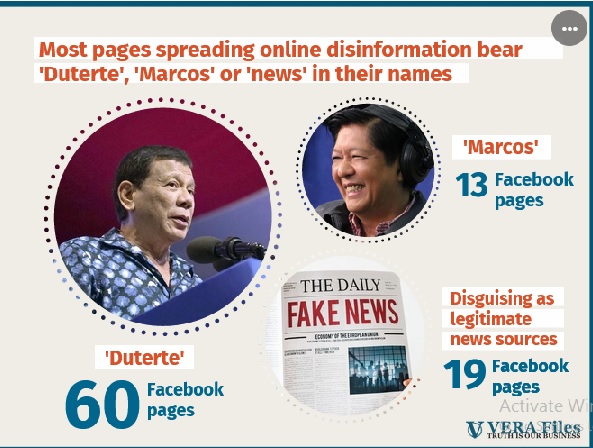
Fake news is the scourge of the social media-addicted society.
Fake news is defined by Collins Dictionary as “false, often sensational, information disseminated under the guise of news reporting.”
It’s also being used to discredit anything that one disdains. That’s why you hear the likes of Presidents Donald Trump and Rodrigo Duterte, known sources of fake news, accusing legitimate news organizations as peddlers of fake news.
VERA Files, which has been fact-checking since the 2016 election campaign and is one of Facebook’s third party fact-checker in the country, has come out with an analysis who benefits most from the proliferation of fake news.
VERA Files’ Jake Soriano, in a study produced under the Southeast Asian Press Alliance 2018 Journalism Fellowship Program, supported by a grant from the Office of the United Nations High Commissioner for Human Rights, analysed 193 online posts over the period April to October 2018 which the VERA Files Fact Check identified and debunked after the organization became part of Facebook’s third-party fact-checking program.
His findings show that “Online disinformation is overwhelmingly political: eight in 10 deceptive posts are about political issues or figures, while the motivations for the rest are either purely economic or unclear. Moreover, six in 10 attack specific individuals or groups, almost always those critical of the Duterte administration.”
“They almost always rely on deception strategies that are crude in execution but are effective in stirring up strong emotions that reinforce deep-rooted biases,” he added.
He said Vice President Maria Leonor ‘Leni’ Robredo, a member of the opposition Liberal Party who has at times been critical of the President, as well as a subject of Duterte’s barbs, is the most common subject of negative coverage by at least 27 fake, false or misleading reports. Sen. Risa Hontiveros of the Akbayan party, who has criticized Duterte on many issues especially violation of human rights, follows with 14.
Sen. Antonio Trillanes III, a fierce critic of Duterte, is the next favorite target of fake news followed by the Liberal Party, the Aquino family, the Catholic Church and former President Benigno Aquino III.
Other highlights of Soriano’s study:
• Some 60 pages that shared disinformation have ‘Duterte’ in their names like Duterte Supporters Worldwide; Duterte Today; Duterte Warriors; President Duterte Astig Supporters; Sara t Duterte Loyal Supporters.
• At least 13 pages that shared fake news bear ‘Marcos’ like Bong Bong Marcos Factual Information and the Marcoses, For Youngsters, BongBong Marcos Loyalists Movement Official Group, BongBong Marcos United, Solid Duterte-Marcos Supporters.
• At least 19 pages that shared fake news purport to be legitimate sources of news. Examples: DU30 Trending News, Duterte News, Duterte News Global, Philippine Trending News.
Robredo said “The President and Mr. Marcos should call out such pages and groups. If they stand for the truth, they should be indignant that their names are being dragged into misinformation campaigns which seek to mislead the Filipino people.”
Soriano said the purveyors of online disinformation have repeatedly relied on three broad techniques: plainly faking information, misleading readers and making false claims.
He explained the thin distinctions among the three fake news forms by giving examples:
“The distinctions between fake, false and misleading reports could be seen as ranges in degrees of being factual, across a spectrum of sorts.
“The fake story about Sen. Hontiveros defending the young men smoking weed is an outright fakery. Among the three types of fake news, it is farthest from verifiable fact: the video thumbnail was fabricated using an editing software, the supposed quote was fabricated, and no legitimate media outfit reported that the senator had defended the seven young men.
“Reports that make false claims fall somewhere in the middle and compared with fakes, are more closely-linked to some real event, albeit still not supported by facts.
“In May, a website called RESURGENT PH, right around the time the issue of amending the Philippines’ government structure was big news, falsely claimed that a survey by Pulse Asia, an independent polling agency, showed more Filipinos being open to federalism.
“To support its claim, the website manipulated survey numbers by adding the figures of those in favor of federalism to those opposed but said they might be open to change some time in the future.
“This conflicts with Pulse Asia’s own analysis of its survey data, saying that this shows the prevailing public sentiment to be “one of opposition to replacing the present unitary system of government with a federal one.
“Misleading reports move closer to the facts, their twists and manipulations being subtler than fakes and false claims.
“In June, a website called TRENDING TOPICS TODAY misled readers by publishing a story claiming that plunder charges had been filed against former president Benigno Aquino III and several other government officials for supposedly shipping gold bars worth billions of dollars to Thailand.
“The plunder case indeed existed, but was filed more than a year ago, something the misleading report conveniently left out. Moreover, the case was already determined to have been based on a document that the Central Bank of the Philippines called ‘spurious.’”
Please read the whole article complete with infographics in http://www.verafiles.org/articles/duterte-allies-reap-most-benefits-disinformation.
for fake news to flourish, survive and spread, money is all that matters. news fakers are paid well, I think. they enjoy free travel in and out the country, their social media subscription paid for as well, almost all of their numerous needs and wants are paid for from tax payers money. ordinary citizens are slugged higher taxes just so these fakers can live in comfort and luxury.
I have been suspicious of surveys as well, the govt getting good ratings, albeit responders of surveys are crowded mostly by fakers.